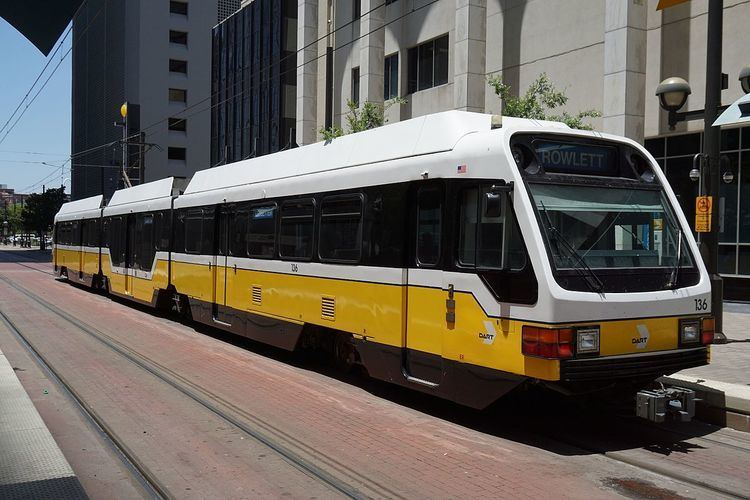Number built 163 | Entered service 2010 Operator(s) DART | |
 | ||
Capacity 98 passengers (seated), 198 (total) per car Car body construction Low alloy high tensile steel | ||
The Kinki Sharyo Super Light Rail Vehicle (SLRV) is a light rail vehicle manufactured by Kinki Sharyo, operated by Dallas Area Rapid Transit (DART), and modified jointly by the two companies.
The SLRVs are longer and can accommodate more passengers than the Kinki Sharyo-built vehicles from which they were developed, known by DART as its standard Light Rail Vehicles (LRVs), which had been operated by DART Light Rail since it began service in June 1996. DART's original LRVs were built as articulated, two-section cars with operator cabs at both ends.
The SLRVs were designed to both increase passenger capacity and to improve the accessibility of DART's light rail system. Each three-section, articulated SLRV measures 123.5 ft (37.64 m) over couplers, while the maximum train length is four articulated cars coupled together, measuring 494 ft (150.57 m) over couplers in total. An individual SLRV is 31 feet (9.4 m) longer and 33,000 pounds (15,000 kg) heavier than the standard LRVs from which they were developed, which were each 92 feet 8 inches (28.24 m) in length and weighed 107,000 pounds (49,000 kg). The SLRVs have a maximum speed of 70 mph (110 km/h) and can accelerate at a rate of 2.3 mph/s (3.4 ft/s2; 1.0 m/s2).
Working in partnership, DART and Kinki Sharyo created the SLRVs by separating the existing two-section LRVs at their articulation joints and inserting an entirely new section in between, thereby rendering them three-section vehicles. The resulting SLRVs are double-articulated, eight-axle cars, in comparison to the single-articulated, six-axle design of the original LRVs. Each SLRV seats 98 passengers and can accommodate roughly 100 more standing passengers, which allows it to accommodate approximately 25 more seated people (and roughly 50 more overall) than a standard, two-section LRV.
The middle section, variously called "Body C", "C Unit", or "C Car", has a low floor and provides step-free access to the SLRV. It was designed primarily to allow passengers in wheelchairs, as well as those with strollers and bicycles, to embark and disembark more quickly and safely. Each SLRV middle section is also equipped with a bicycle rack.
In 2002, the prototype SLRV, car #170, began operating on DART's Blue Line. On June 23, 2008, car #151 became the first SLRV to enter revenue service. DART converted all 115 of its LRVs into SLRVs at a total cost of approximately $190 million, which was more cost effective than buying entirely new light rail vehicles. G. James Morgan of LTK Engineering Services estimated that DART saved over $50 million by converting its LRVs instead of buying new accessible vehicles.
Conversion of an individual LRV into an SLRV took roughly five weeks, with a sixth week for inspection and testing and the vehicle in main line operation by the next week. By March 2010, 84 of DART's 115 LRVs had been converted into SLRVs, and by August 2014, DART was operating a total of 163 SLRVs: all 115 converted LRVs in addition to 48 new vehicles.
DART also modified its light rail platforms between 2007 and 2010 to accommodate the greater overall length and low-floor middle sections of the SLRVs.
